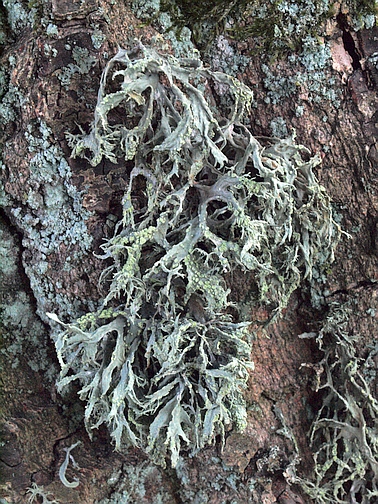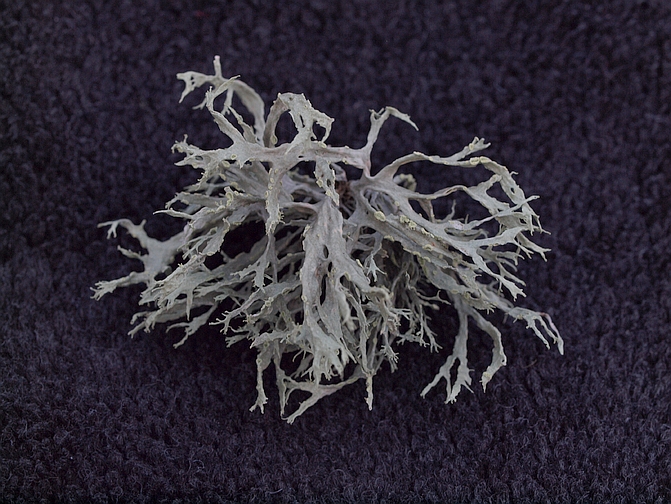Melig takmos (Ramalina farinacea)


Melig
takmos is een struikvormig korstmos, dat groeit op de bast van allerlei
loofbomen (o.a. eik, populier, iep, wilg, es, linde, esdoorn en els).
Het thallus zit met een centrale voet vast aan de boom. Het bestaat uit
afgeplatte, tot 8 cm lange en 0,5 - 3 mm brede, grijsgroene tot
geelgroene, gaffelvormig opgesplitste takjes met een spitse top. Er
kunnen ronde tot ovale, witachtige soralen
op zitten. Apotheciën ontbreken in Nederland vrijwel altijd (8).
De thalli bevatten niet één, maar meerdere algpartners, waaronder twee Trebouxia-soorten
(2,9). Melig takmos logenstraft daarom de opvatting dat een korstmos
bestaat uit de symbiose van één alg met één schimmel. De ene algpartner
functioneert beter in de zomer (hitte, fel licht), terwijl de andere
het beter doet in de winter (koelte, zwakker licht) (1,3). De
algpartners verschillen ook in hun gevoeligheid voor luchtvervuiling
(4). Melig takmos bevat plantenstoffen die de groei van bacteriën
(6,10) en virussen (7) kunnen remmen. Het is minder gevoelig voor
vervuiling dan eikenmos (5).
Naam
Ramalina is afgeleid van het Latijnse woord ramale, dat “twijgjes” of “takjes” betekent. De soortnaam farinacea betekent “melig”, “als vers meel”.
Waar gevonden
We
hebben melig takmos op zeer veel plaatsen gevonden. In Zuidhorn en
Noordhorn groeit het o.a. op eiken langs de Gast, Boslaan en
Langestraat.
Literatuur
1. Casano L, Del Campo E, García Breijo FJ,Reig Armiñana J, Gasulla F, Del Hoyo A, Guéra A, Barreno E (2011). Two Trebouxia algae with different physiological performances are ever present in lichen thalli of Ramalina farinacea. Coexistence versus competition. Envir Microbiol 13:806-818.
2.
Del Campo EM, Gimeno J, De Nova JPG, Casano LM, Gasulla F,
García-Breijo F, Reig Armiñana J, Barreno E (2010) South European
populations of Ramalina farinacea (L.) Ach. share different Trebouxia algae. Bibliotheca Lichenologica 105:247-256.
3.
Del Campo EM, Catalá S, Gimeno J, Del Hoyo A, Martínez-Alberola F,
Casano LM, Grube M, Barreno E (2013) The genetic structure of the
cosmopolitan three-partner lichen Ramalina farinacea evidences the concerted diversification of symbionts. FEMS Microbiol Ecol 83:310-323.
4.
Del Hoyo A, Alvarez R, Del Campo EM, Gasulla F, Barreno E, Casano LM
(2011) Oxidative stress induces distinct physiological responses in the
two Trebouxia phycobionts of the lichen Ramalina farinacea. Ann Bot 107:109-118.
5.
Deltoro VI, Gimeno C, Calatayud A, Barreno E (1999) Effects of SO2
fumigations on photosynthetic CO2 gas exchange, chlorophyll a
fluorescence emission and antioxidant enzymes in the lichens Evernia prunastri and Ramalina farinacea. Physiol Plant 105:648-654.
6. Esimone CO, Adikwu MU (1999) Antimicrobial activity and cytotoxicity of Ramalina farinacea. Fitoterapia 70:428-431.
7. Esimone CO, Grunwald T, Nworu CS, Kuate S, Proksch P, Überla K (2009) Broad spectrum antiviral fractions from the lichen Ramalina farinacea (L.) Ach. Chemotherapy 55:119-126.
8. Melig takmos. Document op nl.wikipedia.org.
9. Moya P, Molins A, Martínez-Alberola F, Muggia L, Barreno E (2017) Unexpected associated microalgal diversity in the lichen Ramalina farinacea is uncovered by pyrosequencing analyses. PLoS ONE 12:e0175091.
10.
Tay T, Türk AÖ, Yilmaz M, Türk H, Kivanç M (2004) Evaluation of the
antimicrobial activity of the acetone extract of the lichen Ramalina farinacea and its (+)-usnic acid, norstictic acid, and protocetraric acid constituents. Z Naturforsch 59:384-388.
Terug naar de soortenlijst
